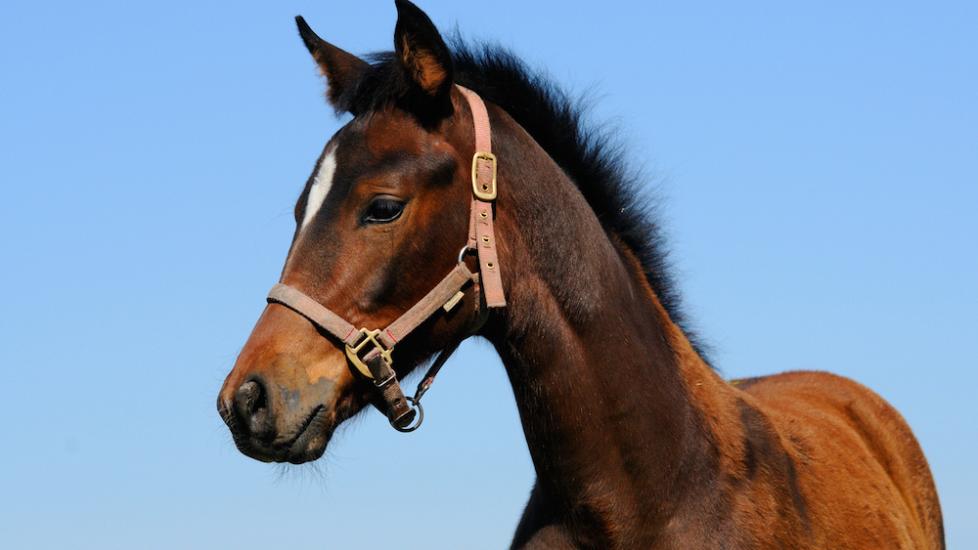Training Foals
When to Start Training a Foal
The birth of a foal is an exciting time for any horse owner. Whether your horse is born on a breeding farm or in your backyard, training a foal is a gradual process that starts as soon as the foal is born. The following is a general timeline for training foals:
Handling
Foals should be handled gently and regularly from the first day of life. This will help to develop a trusting relationship between the foal and handler. While the first few days are crucial in the mare/foal relationship, getting both horses used to you being involved and touching the foal will decrease stress down the road. Short interactive sessions can gradually increase over time, and should include lots of petting and making sure the foal becomes comfortable having hands on them including the belly, ears, feet, and hind end. This will make them more at ease for later skills such as haltering, tacking, and other daily practices. As they get used to being touched, gradually work on picking their feet up, as this will be a practical skill to make life easier for farriers and veterinary care.
As foals age, some can become a bit mouthy, or start to nip at you as a sign of play or affection. While this may seem “cute,” especially in mini or pony foals, this can predispose them to potentially dangerous behaviors if allowed to continue, so this behavior should be nipped in the bud early on.
Socialization
The foal should be allowed to interact with other horses as soon as possible. This will help to develop social skills and reduce the risk of aggression towards other horses later in life.
After your mare and foal adjust to their new life together, it is common practice to turn small groups of mares and foals out together, if all the mares are gentle and non-aggressive. This helps promote socialization for the youngsters, and adequate exercise.
Weaning
Foals are typically weaned between 4-6 months of age. This is a gradual process that involves separating the foal from the mare for increasingly longer periods of time until the foal is fully weaned. Sometimes a mare will wean a foal on their own, other times this must be enforced by the handler.
There are two major approaches to weaning: one which involves separation when the foal and mare can still see and hear each other, and perhaps touch nose to nose; the other involves separating them by a much larger distance where they cannot see or hear each other. Both methods have certain advantages as well as cautions; discuss with your veterinarian which route may be best for your mare and foal based on their health and temperaments.
How to Halter Train a Foal
Halters should only be worn when the foal is supervised at first for short periods, or a breakaway halter should be used. To ensure an appropriate fit, you should be able to fit 1-2 fingers between the foal’s face and the halter so it’s not too loose, or too tight to cause discomfort. A breakaway halter is typically made of leather or another soft material that can break if too much force is applied. This is to prevent any serious or fatal neck injury that may occur if the foal gets the halter stuck on something and pulls back.
Haltering should be performed in a quiet, calm environment that the horse knows. They may run around, get anxious or excited, or try to hide the first time the halter is put on, so keep them in a safe space and let them adjust on their own. Try to use positive enforcement when putting the halter on, so it becomes a non-stressful situation.
For difficult foals, some trainers may recommend the use of a “catch rope,” which is a very short lead rope that doesn’t reach the ground so you can get a hold of your foal easier, without the potential danger of entangling their legs in the rope.
Groundwork
Groundwork can begin once a foal understands wearing a halter. This involves teaching the foal to lead, stand quietly for grooming and handling, and respond to basic commands.
To work on leading, gentle pressure should be applied when pulling on the lead rope; pressure stops once the foal moves in the direction you asked, as a method of positive enforcement. More involved groundwork continues as the horse ages. Laying proper groundwork and manners when handling makes veterinary visits, farrier care, and later training much easier as your foal develops into a full-grown horse.
Featured Image: iStock.com/Abramova_Kseniya
